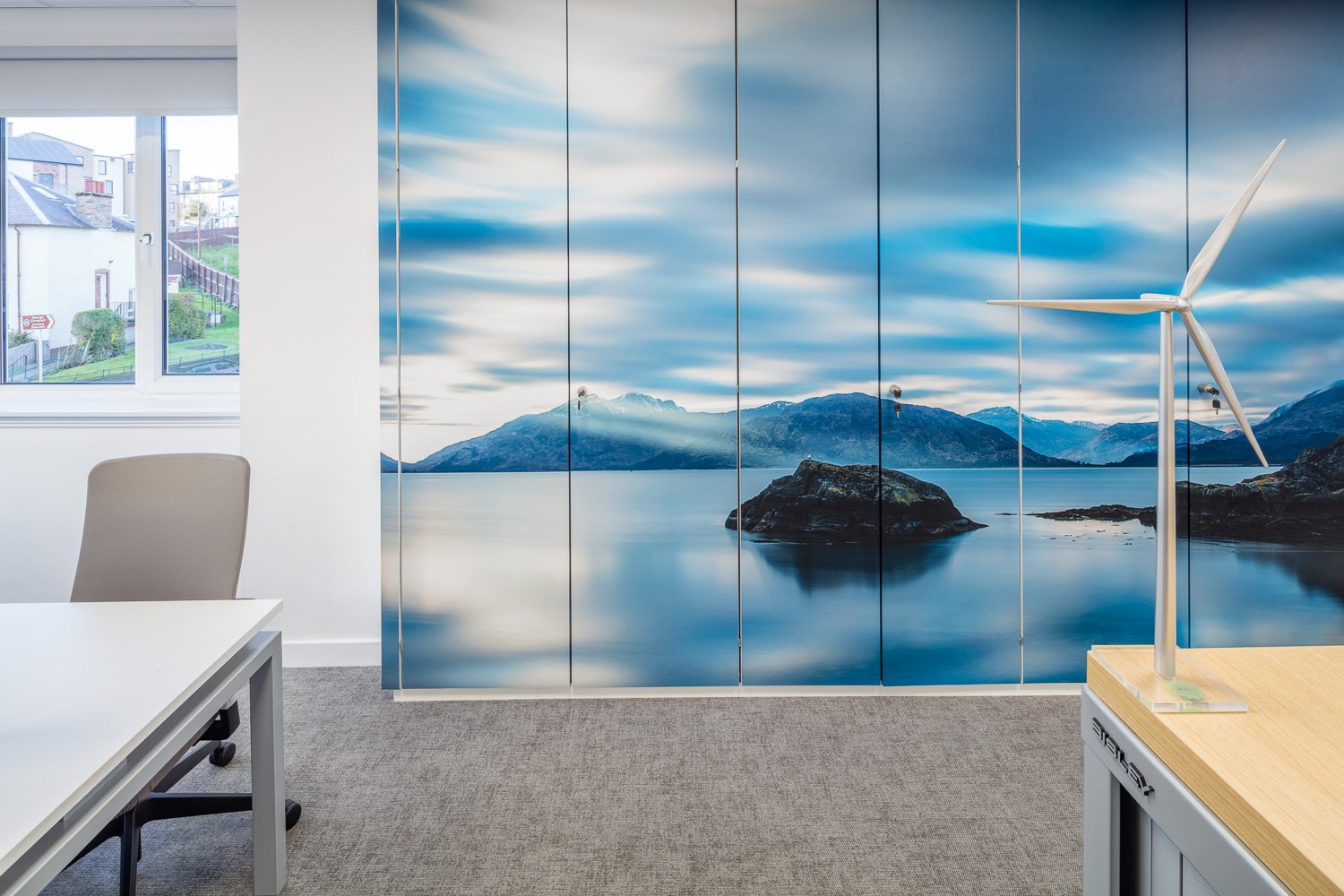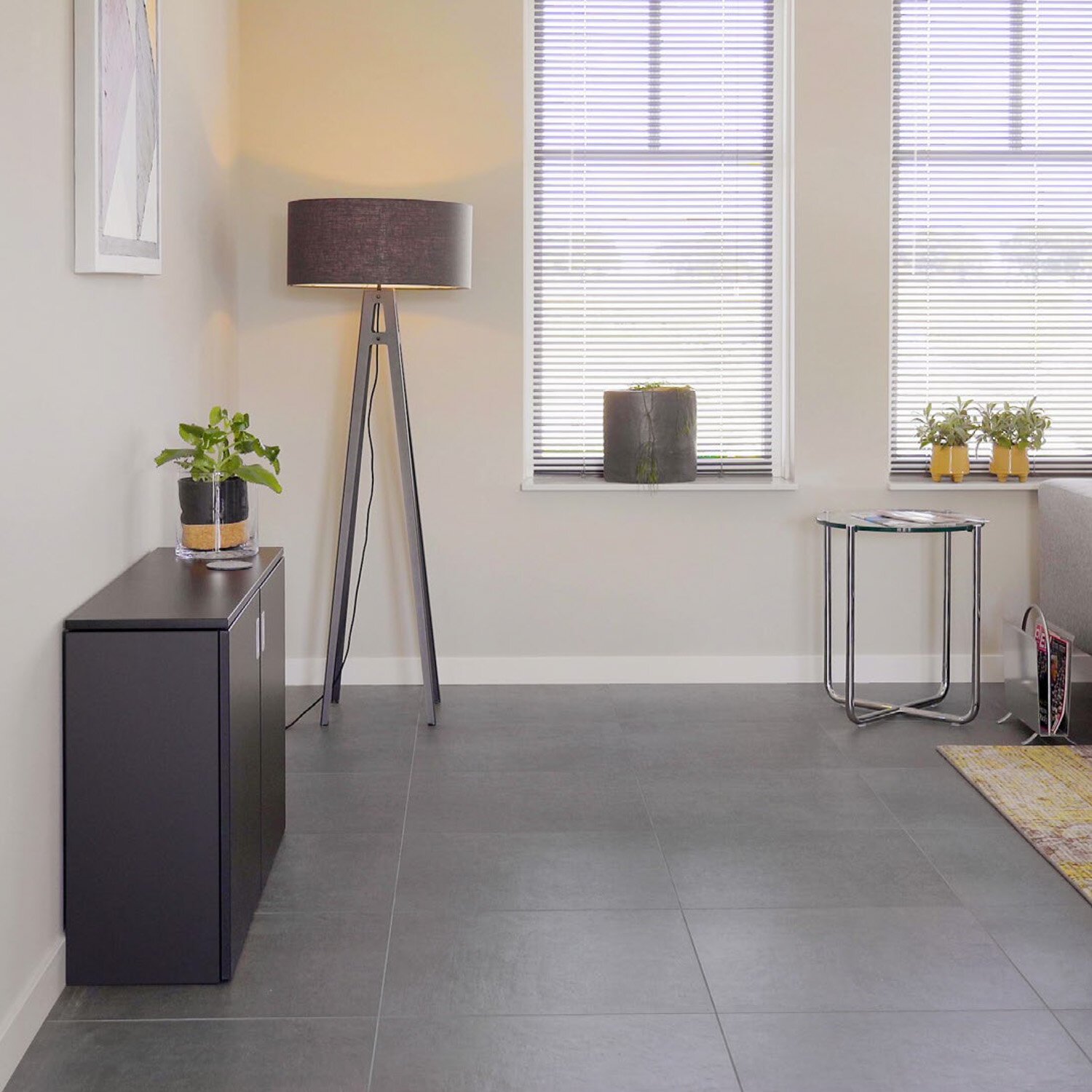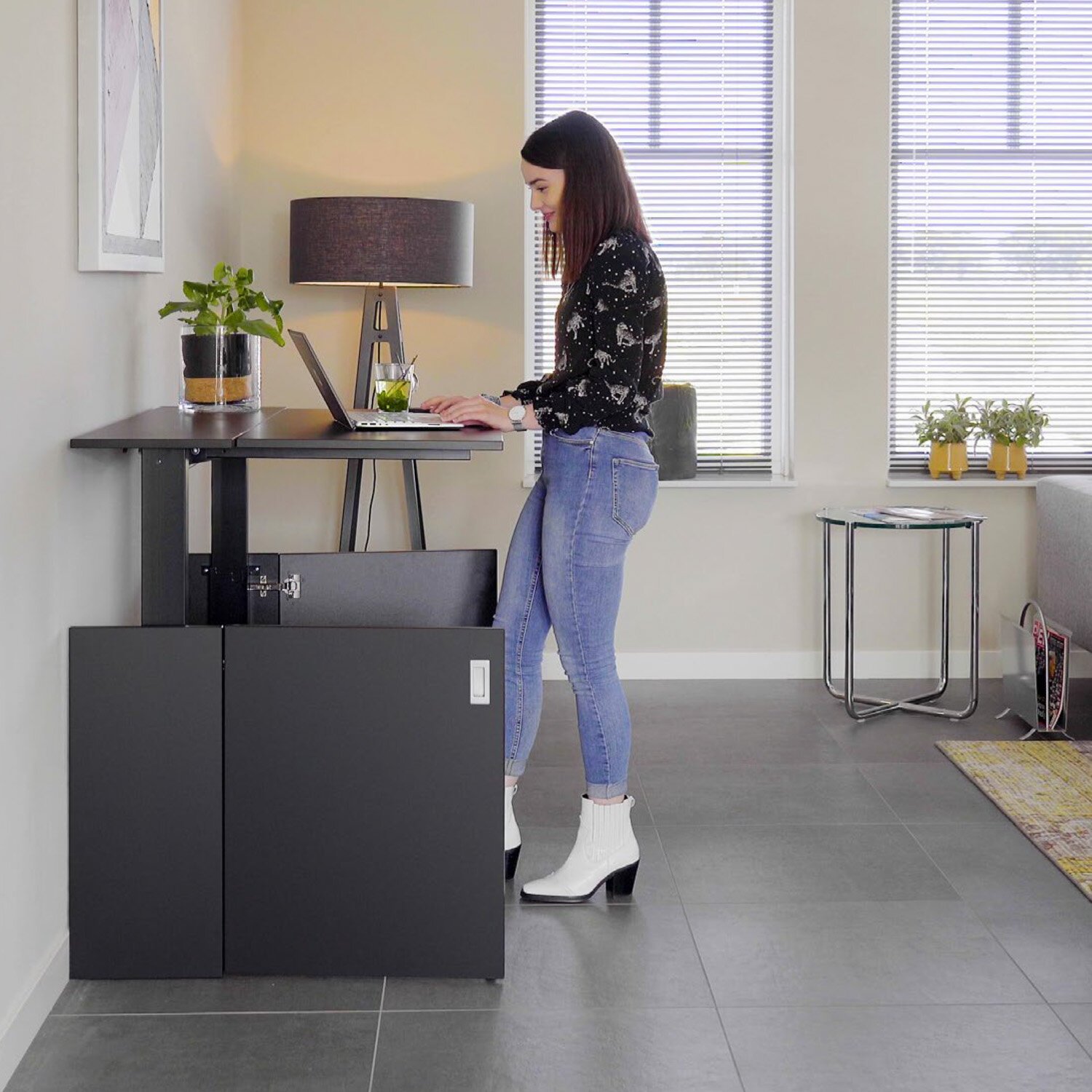Business Disruption – Moving or Refurbishing Offices is every MD’s nightmare
Note: this blog was written way before the pandemic, but probably even more actual today!
Should I Move or Refurbish My Current Office?
Tough question, right?
Moving to a new office entails a lot of stress. You need to find the right real estate agency to help you find the right property. Then you need to negotiate and decorate. Plus, should you keep some or all of your existing furniture? Should you buy everything new?
Refurbishing isn’t that easy, either. The main challenge is that you have to keep operations going, stay productive and minimise business disruption. All this while you also supervise a project that can take weeks or months.
Can you really find out what’s the best alternative on your own? Can you factor in all the business hours lost in both cases, along with the investment? And, more importantly, how do you know for sure that you’ve outgrown your current office space?
At Amos Beech, we have consulted dozens of companies that were ready to spend a lot because they thought they needed a bigger space. Our research and expertise revealed that all they needed was to get more out of their current one.
Yes, a skilled team of designers and office refurbishing experts can help you save a lot on office real estate by ‘simply’ re-arranging the furniture in your office.
But that’s not always the case. Sometimes you really need to move. The same team of expert designers and contractors can help you turn your new office into a space that every single employee loves.
A blog by Roy James:
Moving a business is not easy, there are so many things to think about, so much to do, along with minimising the disruption to your organisation, so its little wonder that moving or refurbishing offices is often low on the agenda until the last minute. That brings about its pressures as you realise too late that you may have to make a rushed decision.
Moving or refurbishing offices?
Refurbishing an existing office is almost harder. Although there is less to arrange, in one sense, there is the added complication of trying to maintain the services and revenue of your company yet expect it to bear with the disruption which potentially can run from weeks to months.
Edinburgh Park, Scotland’s premier business park
Even when you have made the decision of whether to move or refurbish, where do you start? Where did that decision come from? Was it rushed or an informed, logical decision based on robust consideration and challenged against the strategic growth plans of the company?
This is clearly outside your comfort zone. You want the best for your company – minimal disruption and continuity for your customer but along with it you need to deliver on company goals and maintain value to shareholders.
Let’s explore this scenario. Your lease is up for renewal - you obviously have two options - do you stay or do you move? And, as we all know, there are pros and cons to moving or refurbishing offices. The question is, how can I make an informed decision?
One way to do it
Who should you ask? Or is it my decision? Should I know what to do?
Yes, there are consultants out there that would advise and give well informed advice but it doesn’t end there. They are often from a big, even global company and before you know it you are in the maze of consultancy that is both expensive and protracted as you engage with just about every consultant under the sun.
Maxim Office Park Lanarkshire, between Glasgow and Edinburgh designed by Glasgow architect Keppie Design
Don’t get me wrong, you will end up with first class advice but I have two arguments - it will be both expensive, and quite frankly, take months which as I started with, it is time you often don’t have.
But is there really another way?
Actually, there is, it’s based on trust and comes from a sector of the market you least expect.
Before I start, though, let’s talk about trust as it’s one of the most valuable and effective attributes in business. In scenarios such as this it’s pretty crucial. For this to work we need to engage with someone who is wanting to help you and trust is a two-way street.
This sector is quite unique, often labelled as office furniture suppliers or fit out companies but actually quite different.
And, yes, just like any other company, they are looking to create revenue and grow profits but you are talking to the right person one time here!
Okay, that sounds hackneyed and I apologise but it’s true, just please let me explain.
So, let’s briefly (if I can) expand this scenario out a little further.
Your lease is expiring and you need to make a decision on what to do. You realise this is not a decision you can make without being informed so you go to a reputable consultancy firm or architect practice in Glasgow or Edinburgh who, for a fee, help you evaluate the space you have, the growth plans of the company, the vision and strategic plan and come back with a suggestion of what they feel is what you need to do. But that’s it, they suggest for you to move, they have suggested how much space you need to achieve your growth plans and now… now what?
From here you are often now on a journey with this consultancy as they offer to find you space. They even offer to manage the whole project for you (what a relief!) and go down a merry passage of contracting interior designers, electrical engineers, mechanical and ventilation consultants, quantity surveyors and project managers as they create the perfect solution for you (oh and they take a cut of everything that happens).
Moving or refurbishing offices, is there another way?
But there’s just a few points they missed.
You are now pretty alienated from the process; all these consultants are designing something that they want to be proud of (and rightly so) but that tends to drift away from any budget you may have had. You end up with a Rolls Royce design and, although you have fallen in love with it, you just can’t really justify the expenditure, and more than this to get this far the process has cost you a lot of money!
So here you are with a project over-budget, with a re-look only going to cost more money and time and this is the point that if you hadn’t already been disillusioned by this whole process you are now.
I could go on. Say you even get on site, you have a consultancy pulling together different trades to realise the project, they have ever so cleverly gone to tender to get you the `best price’ but the disconnection carries on site. The electricians fit the floor boxes, the furniture company fit the desking, and, lo and behold, they weren’t communicating with each other during the final design and half of it doesn’t match up creating more delays and potential cost.
The other way
As I said, it’s a different approach and it’s a single, unified one to all of the above. These companies come in and work with CEO’s and MD’s to evaluate the needs of the business. They have no ulterior motive as to whether you move or stay, they aren’t looking for a cut on any third party consultancy, they just have a great understanding of what is important to business.
So you go through the same process of answering the questions about moving or refurbishing offices, but in a completely different way. Yes you will need to engage with a property agent to find a property but you are looking for one based on a decision made by someone who has no interest in property letting. Going on from that they are not just trying to provide a solution, they are working to a budget, have in-house capabilities that do not require expensive third party input and, most importantly, are keeping you engaged and close to the decision whilst co-ordinating all the different phases of the project.
Maxim Office Park Glasgow, state of the art architectural design
On site, being the client, connection is much closer, things happen so much quicker, changes you may need to make don’t need to through a long process, (and believe me it is long) it goes direct, costs a lot less and contractors are working to a common goal rather than just focusing on their own scope of works.
So where is the catch?
There is none, but as I said it’s based on trust. These companies invest a lot of time up-front helping companies make informed decisions and often it’s not until a lease is signed, when they have done months of work, that they get a return. For them it’s a worthwhile investment, for the client it is good value as they get what they need, when they need, with direct input whenever they like and a partner that is only interested in delivering something fit for purpose.
The hard bit is when corporate say `we need to go to tender’ as often they say that at the point when these companies have invested heavily in the project, especially as they don’t say that when they are using a paid consultancy as they know they are getting competitive comparative quotes from them . It feels good value but all you are actually getting is a protracted, expensive solution that can be scarily detached from the original CEO’s vision. Please everyone let us understand and embrace the speed of trust.
I know blogs are meant to be informative, unbiased (not long – please forgive me) and not `selling’ but sorry, I can’t say all this and not tell you where to go, I’m too obsessed, too passionate and believe in ourselves to this extent (and I’m only writing this as it was an in-house competition) but you need to talk to Amos Beech.
Contact me or one of my colleagues via:
This was a blog by Roy James
Amos Beech ran an internal blog competition. The above article, written by Roy James, won the category for being ‘website worthy’. Roy was the Operations Director at the time (see video below) and he is known for being a man of few words. Consequentially, we were all very impressed with his 1300 word blog! He has made his point very well.
Date of first publication: December 8th, 2018
For more info about some of the fit out and refurbishment projects that we have done click on the button below:
A great working from home solution!
An ergonomic sit-stand desk hidden in a small cupboard in the colour of your interior! That’s HomeFit©.
Working from home is probably here to stay. When the vaccine is fully rolled out and things can return to normal, many businesses and organisations will have come to the conclusion that working from home has it’s advantages. Just think about the saving on expensive office space, commuting time, environmental impact, etc.
Working from home and ergonomics
However, it is possible that the home office environment may have a negative impact on the home office worker from an ergonomic point of view.
“Working at a desk is the new smoking” we wrote earlier and that was about professionally furnished offices!
At home as well as in the office, it is important to work in alternating sitting and standing postures. Most kitchen tables don’t allow this to happen.
If you have the luxury of a separate study or spacious home office, you would probably choose an adjustable desk and a decent office chair. However, not everyone has the space for such a home office.
That is why Amos Beech in Scotland, introduces the HomeFit© working from home solution!
With a width of only 105 cm and a depth of 30 cm, HomeFit© is no bigger than a shoe cupboard or a large suitcase. The unique design and many colour options will guarantee that HomeFit© blends seamlessly into any living room.
HomeFit© is the professional workstation for the home; fully electrically adjustable in height from 68-118 cm, so that you can work at the correct height both sitting down and standing up. Thanks to its compact size, there is always a place in the living room where HomeFit© is at its best.
“Scroll down for price and order form button”
Click on the image above to play the video
The transformation from an easily overlooked piece of home furniture, into a fully functional office workstation, can be done quickly and easily by opening the doors and raising the worktop. The worktop also contains the controls for height the adjustment. The handy storage tray in the cupboard provides space for work related items such as laptop, mouse or work folder.
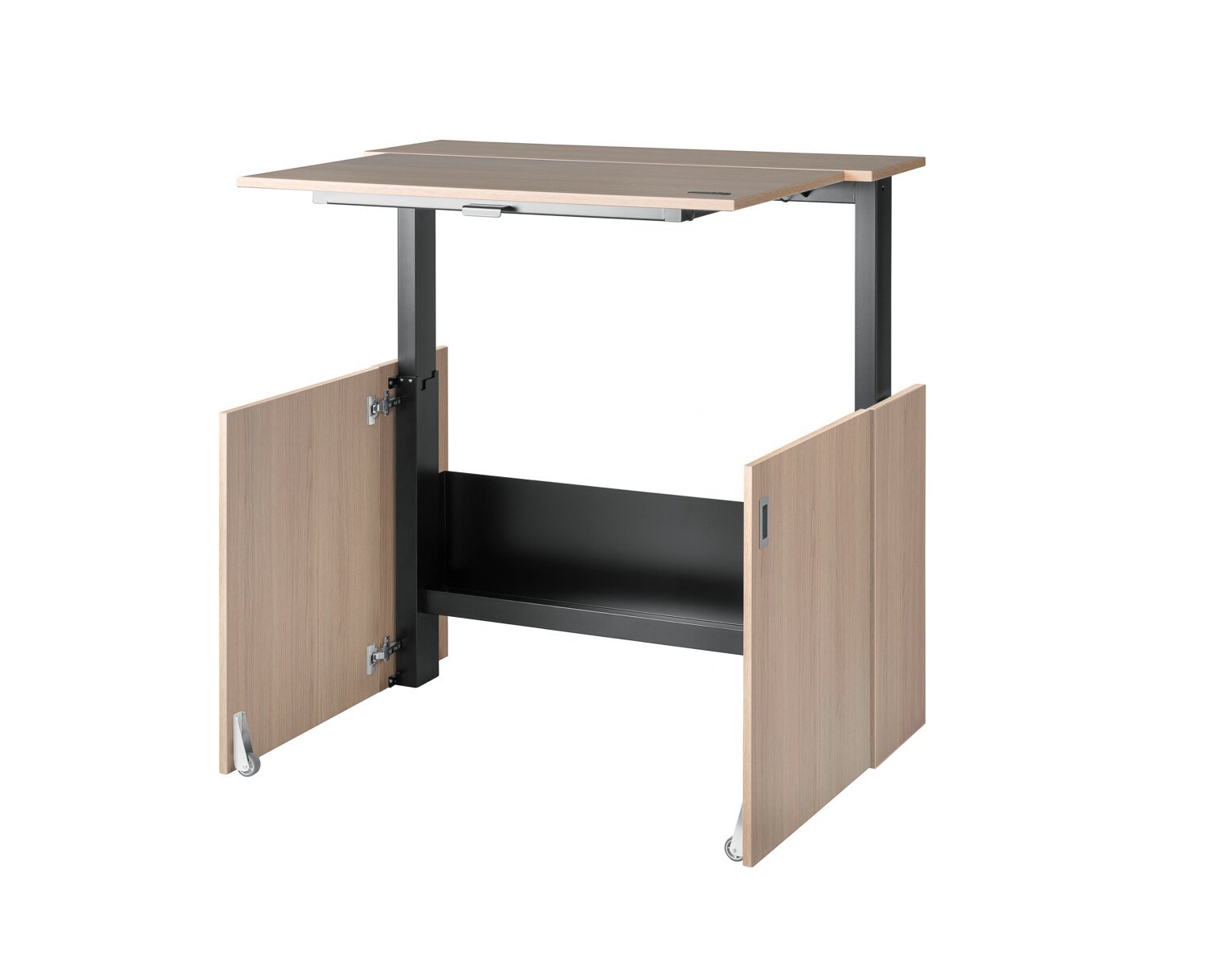
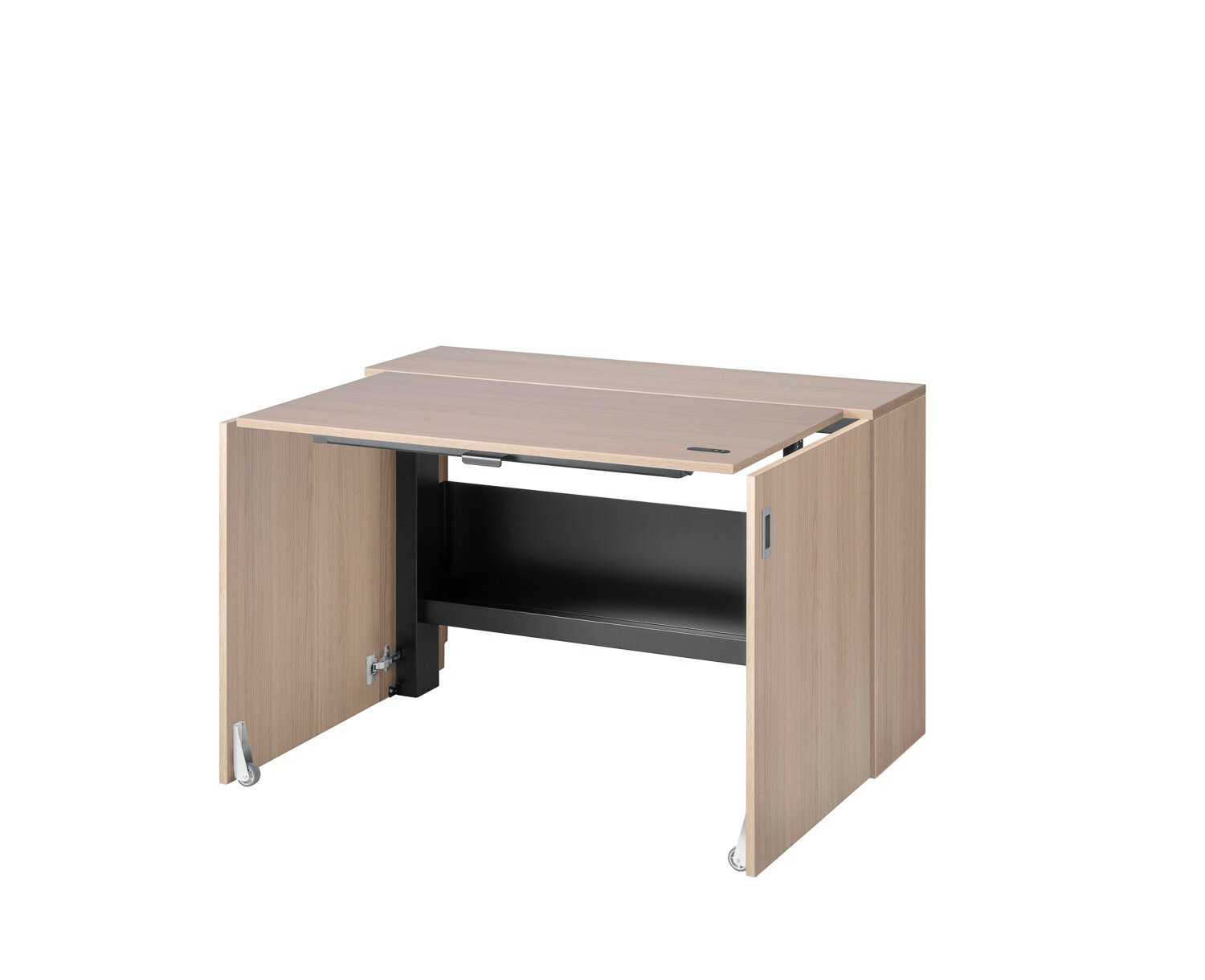

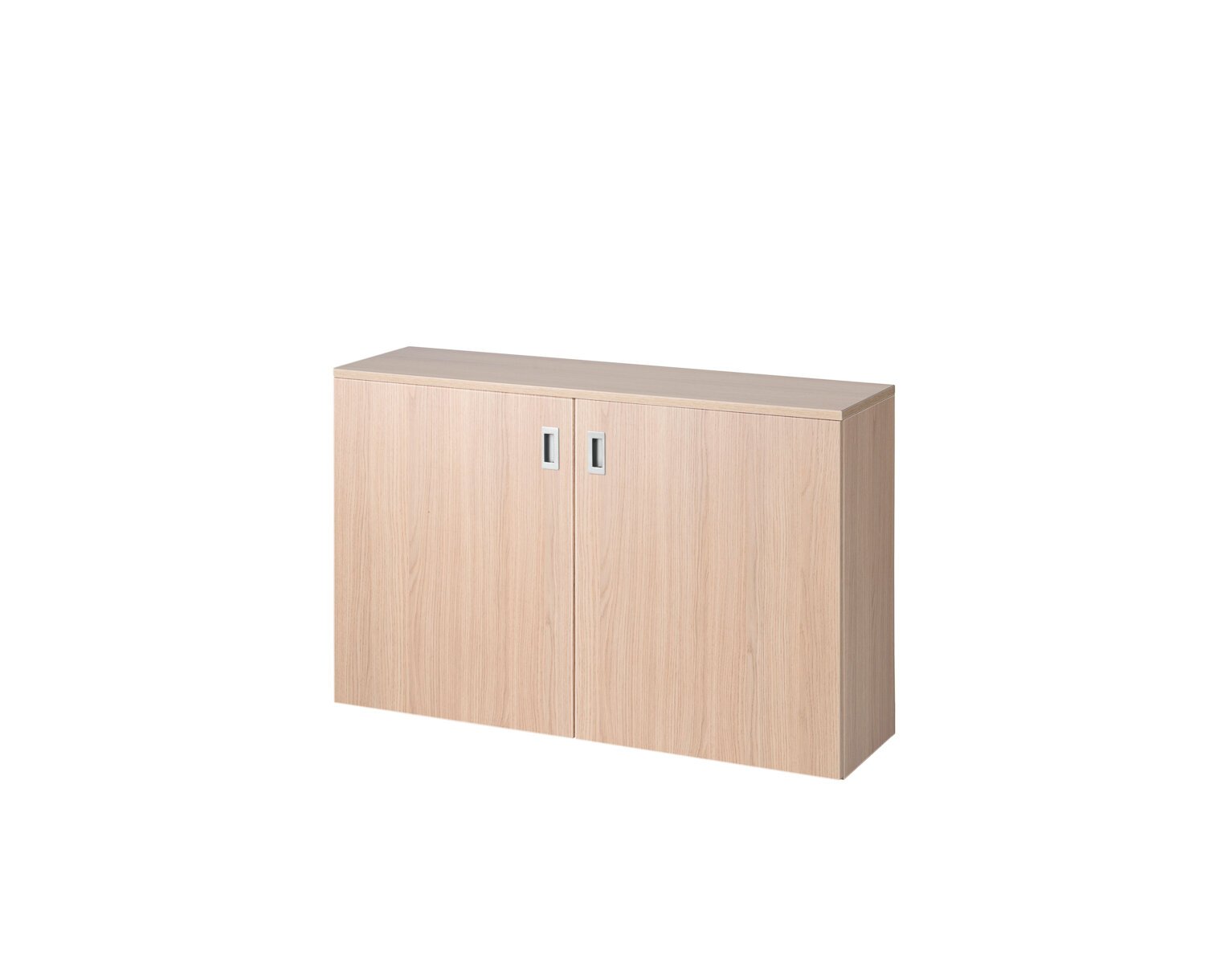

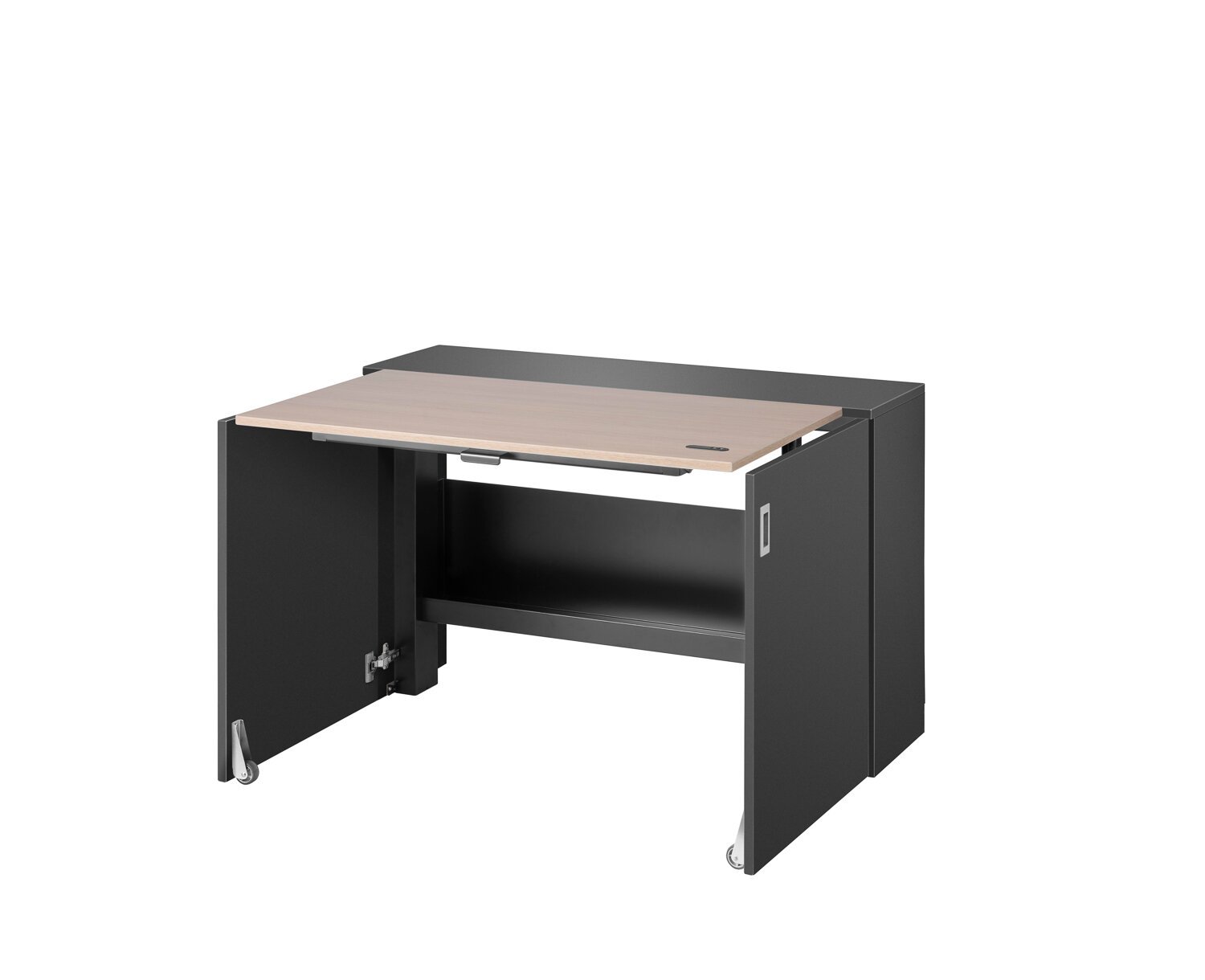


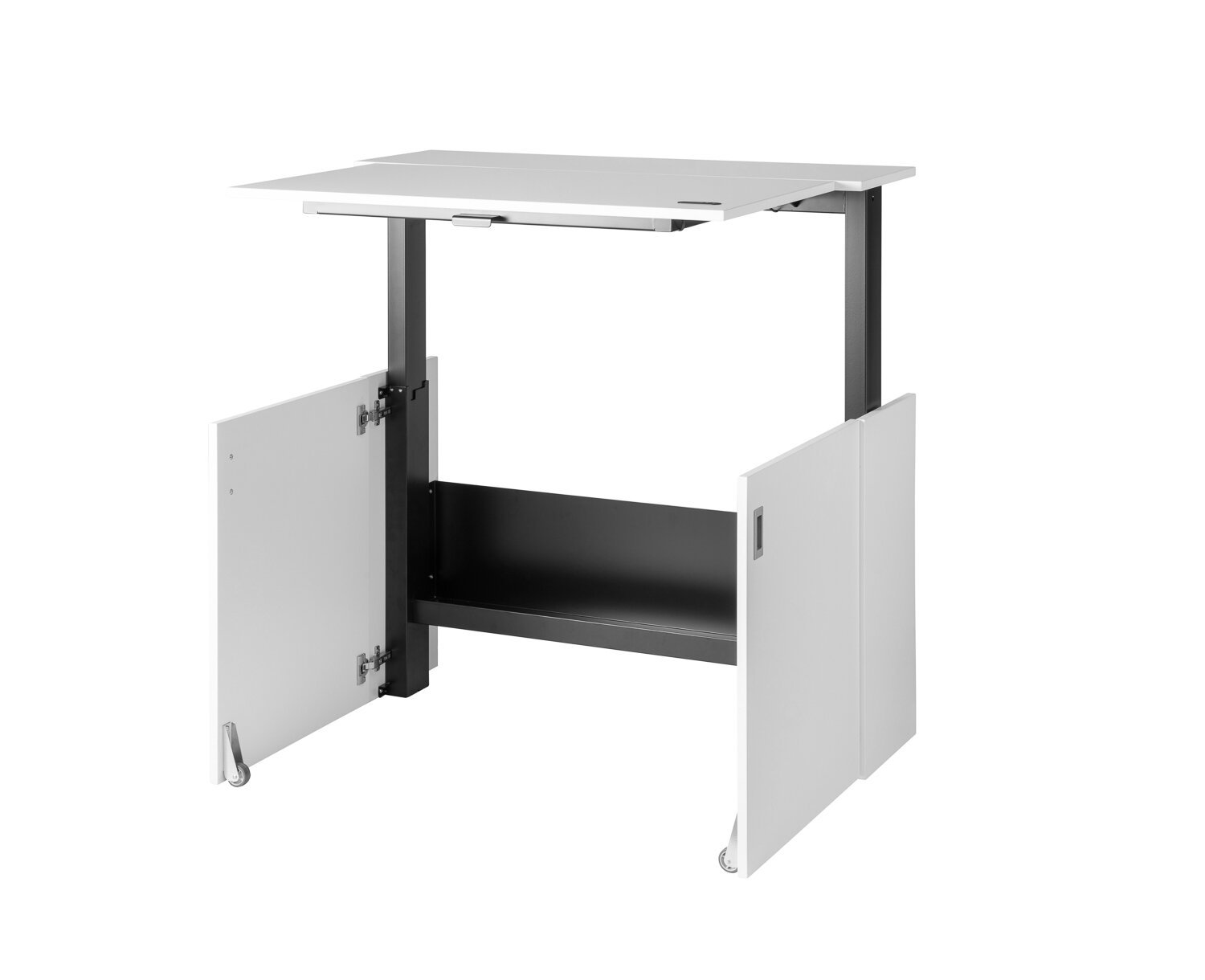




Specifications
electric sit-stand desk, adjustable in height between 68 and 118 cm
black powder coated metal frame with aluminium door handles
safe-stop height adjustment; height adjustment stops automatically if counter pressure is detected
door lock in open position; the right door locks automatically when opened up to prevent the desk from tipping over. The lock can be released with a simple foot control.)
doors fitted with castors for easy opening and stability when opened
convenient metal storage tray for laptop and other office accessories
HomeFit® is delivered fully assembled in a cardboard box
W x D x H: 1050 x 298 x 680
sit-stand heigth: 680 - 1180
Complies to:
NEN-NPR 1813: guideline for office furniture and their application
NEN-EN 527-1: European standard for work tables and desks
ISO standards: 9001 quality, ISO 14001 environment and ISO 26000
CSR guidelines
ILO - labour and social standards
Colours and lead-times
Approx 15 working days for the following standard colours:
Natural Oak 57
white E0-00
Black 720
4-6 weeks for other colours
available from November 2020
for other finishes, click here (pdf file).
For more information contact the office:
Offices as a Service? The Changing Nature of Commercial Property in 2021
There’s no doubt that the coronavirus has been something of a game-changer for various industries and marketplaces, with some entities having fared considerably better than others since March 2020.
The commercial property market offers a relevant case in point, with the construction of new offices in central London having declined by 50% in the six months to September 2020.
The UK capital is something of a trail-blazer in the world of commercial property, so it should come as no surprise that investment volumes in Scotland also fell to £1.3 billion in 2020 (down from £2.1 billion during the previous year).
This decline has been triggered by various factors, of course, from the rise in business closures to the increased focus on home and remote working in the UK. While this trend is set to continue, however, there’s also a growing demand for the development of tailored, collegial and safe workplaces that allow for face-to-face contact between employees and clients alike.
Re-imagining the Office Space in the Wake of Covid-19
While a number of global corporations (including Amazon and American Express) have committed to extended remote working opportunities indefinitely, the majority of small businesses are keen on getting their staff members back in the office as lockdown measures are eased across the globe.
As we’ve already touched on, however, both employers and employees want to re-imagine workplaces in a post-Covid world, enabling colleagues to work safely and productively without encountering the social and cultural disconnect associated with operating remotely over an extended period of time.
The rigidity and inability of modern workplaces
In this respect, the coronavirus has been something of a revelation, raising the question of why something as challenging and complex as remote or hybrid working remains such a desirable option for employees even outside the confines of a global pandemic?
The answer clearly lies in the nature of ‘modern’ workplaces, their rigidity and inability to allow for either social distancing protocols or the individual needs of specific business-owners.
Fortunately this offce has undergone a bit of a face lift 🙂, you can check it out here!
How Will Workplaces Change Post-Coronavirus?
Clearly, the trend set in London will become most prevalent in similarly competitive and crowded marketplaces, with Edinburgh offering a relevant case in point.
There’s undoubtedly a growing pressure on square footage in the Scottish capital, as geographical restrictions and increased demand continues to place constraints on the ability of developers to build and expand new commercial properties.
This trend is also prevalent in Glasgow, of course, where development rates have continued to stall over time and the total vacancy rate for Grade A office spaces declined to an all-time low of 9.9% in 2018.
The commercial property market needs a increasingly flexible and comprehensive approach from landlords.
This, combined with need for increased social distancing, demands an increasingly flexible and comprehensive approach from landlords and developers alike, who must commit to collaborating with clients when fitting out spaces and focus on providing bespoke workplaces for tenants.
This type of focused and bespoke approach will definitely benefit businesses that want to create a safe and manageable workspace as the Covid restrictions ease, while potentially optimising occupancy rates for clients across a broad range of industries.
This collaborative way of thinking certainly inspired the office refurbishment in Fugro’s new location at the Hariot Watt Research Park, as we worked closely with the landlord (and client) to create a CAT A fit-out that tailored everything from ceiling heights and partition placement to mechanical and electrical installations to suit the exact needs of the client.
If we extend this example to a post-Covid world, we begin to imagine how office spaces can be structured and refurbished to optimise space, drive efficiency and help specific clients to maximise their commercial property budgets.
What Does This Mean for the Commercial Property Market?
If we look at this trend in its wider context, it’s apparent that it has its origins in the type of serviced office space that has become prevalent in major UK cities like London, Leeds and Manchester.
Serviced office space essentially refers to furnished and fully-equipped and pay-as-you-use locations, which are usually managed by independent operators. They will rent out single serviced offices or whole floors on rolling contracts to clients, affording them access to ready-to-utilise and viable locations in double-quick time.
However, these spaces are targeted at types of business rather than individual clients, while their largely generic workplace design offers little in the way of flexibility and social distancing capacity.
By evolving the concept to create bespoke spaces for specific clients, however, we’re now seeing a scenario where offices are being marketed as a service (in the same way that Saas has grown into a comprehensive licensing and delivery model for software).
This is a huge opportunity for stakeholders like landlords and developers to shape the future landscape of the commercial property market, as it evolves to meet the changing needs of clients and adapt to variable market conditions.
Read more about how we can help:
Date of first publication: December 12th, 2021
























